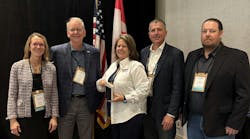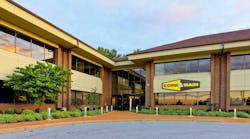Catching Up on Culvert Repair
Culverts and other storm water installations in Oregon face a special challenge, according to Oregon Department of Transportation (ODOT) hydraulic engineer Dan Gunther.
“For the last few years, if we planned any work on a culvert in fish-bearing streams, it would trigger the need for a fish passage, and that was typically too expensive for the proposed project budget—sometimes we’d find ourselves being required by the environmental regulations to construct a bridge to fix a culvert,” Gunther said.
Consequently, ODOT frequently has had to hold off culvert repairs if fish passage requirements were triggered. Now, many of these culverts are in critical condition.
Currently, some projects are being approved for relatively low-cost rehabilitation. One of these is the recently completed Trout Creek Overflow Culvert Repair located at milepost 13.1 on Oregon Highway 281. This 526-ft overflow culvert running parallel to the west side of the highway is made of 72-in. corrugated metal pipe (CMP). Time had not been kind to the culvert.
“When we actually got in the pipe and took a look, we found that it was worse than we thought,” Gunther said. Inverts were near failure or completely rusted out, and large voids were visible behind rotten patches for most of the culvert’s length. Oregon’s famous storm events also took a toll; rocks and sand pushed along by occasional high-velocity flows had damaged the CMP.
The 526-ft overflow culvert runs parallel to the west side of the highway and is made of 72-in. corrugated metal pipe.
Analyzing Options
Trench and replace was ruled out almost immediately. “There are big trees in this area, and residential areas nearby,” Gunther said. “Trenching would have been too disruptive.”
When trenching is not a possibility, ODOT has tended to rely on cured-in-place pipe (CIPP) for rehabilitation. But here the department decided to test a solution called CentriPipe. This technology already had been implemented in many states, but this was ODOT’s first time trying the product.
CentriPipe is a centrifugally cast concrete pipe (CCCP) technology, developed by AP/M Permaform, that employs a precisely controlled SpinCaster and a fine aggregate cementitious liner to repair pipe from the inside. The sled-mounted SpinCaster is inserted into pipe and withdrawn at variable speeds while thin layers of cementitious material are evenly applied. The result is a smooth, watertight repair that does not rely on the failing substrate for support—in effect, a “custom” concrete pipe is cast within the old pipe.
Because the new concrete pipe does not need to be especially thick—an inch or so over the top rib of the corrugation is typical—and because it adheres tightly to the inner surface of existing sewers (leaving no annular space for water flow), CentriPipe repairs typically do not reduce hydraulic flows. The roughness of the pipe (Manning’s n value) decreases enough to preserve the original capacity. For large-diameter pipe, costs per lineal foot typically are less than CIPP.
Before rehabilitation, the corrugated metal pipe showed signs of physical damage due in part to storms and debris pushed through by high-velocity flows.
Overcoming Challenges
ODOT chose SunCoast Environmental NW Inc., a Vancouver, Wash.-based firm experienced in several sewer repair technologies, including CIPP and fiberglass inserts, as contractor for the rehabilitation. “This was one of our first projects in Oregon, aside from some municipal projects, and our very first for ODOT,” said Jim Atchison, owner of SunCoast. It turned out to be quite a challenge—the badly deteriorated pipe and the high water table required more initial work than is usual for a project like this.
Preparation for this type of CCCP repair typically is minimal. The sled requires a smooth invert so cement layers can be applied evenly, and the pipe interior must be clean and reasonably smooth. New, shallow inverts often are poured with self-leveling cement, and pipes usually are pressure washed and patched as needed. Because the cementitious materials adhere well to most surfaces, even if damp, dewatering generally is not a difficult chore.
But the Trout Creek Overflow Culvert is near a stream coming from Mount Hood, and the water table is exceptionally high year round. SunCoast did normal preparation work, but pressure from the mountainside forced high amounts of infiltration through the dilapidated pipe, especially at points approximately 2 ft up the pipe walls. The pressure and amount of the infiltration was enough to prevent good cement adherence and coverage.
This was a puzzling challenge, and slowed work for a few days. Ultimately, ODOT and SunCoast hit on a solution: A national chemical grouting contractor, with experience in this specific situation, was called in to apply urethane-based grouting in the many voids created behind the corroding pipe. After a day on site, and after building a small coffer dam, the Trout Creek pipe was dry enough for normal CentriPipe operations to resume.
SunCoast set up on a patch of ground, about 20 by 8 ft, by a drain near the middle of the culvert. This highlights another advantage of CentriPipe; staging areas are relatively small, compared to competing solutions. By inserting the SpinCaster in the middle drain, SunCoast was able to work from the ends of the culvert to the drain. Two passes were required, each laying down a 0.5-in. layer.
Rehab Solution
The material applied was PL-8000, a fiber-reinforced fine aggregate liner with short curing times, high structural strength, and adherence to most existing substrates, including CMP and HDPE.
“We had an inspector on site, but I wanted to learn more about this type of rehabilitation, so I also inspected as work was being done,” said ODOT hydraulic engineer David McDonald. “After the infiltration issues were resolved, the cast itself went smoothly.” McDonald inspected visually by walking the pipe shortly after casting, looking for even, smooth layers and good adherence to the CMP interior.
“I was concerned about the annular space between the CMP and the new concrete, because we really didn’t want water flowing in there,” McDonald said. “But it didn’t seem to be a problem—I observed good contact, and the space was sealed up well.” Layer thickness also can be measured with depth gauges and by keeping track of volume of material applied. On this project, SunCoast applied two layers, and total thickness was an inch above the CMP corrugations. Due to the infiltration issues, total time on site was almost a month, but actual spray time was just more than a week.
“This was the first time we’ve tried this type of rehabilitation, at least in this [ODOT] region,” McDonald said. “And for this it was great; I think we can do more of these now, and on smaller culverts.”
“This project is a good first step toward getting our culverts back in shape, now that we have the opportunity,” Gunther said. “CentriPipe may not be right for every situation, but it certainly seems like it will become part of the toolbox.”


